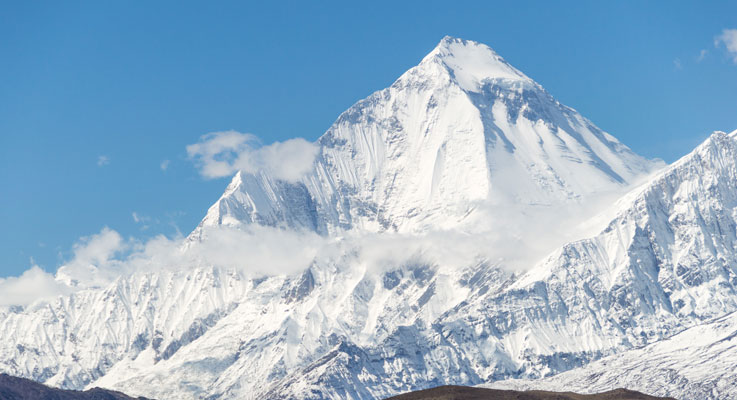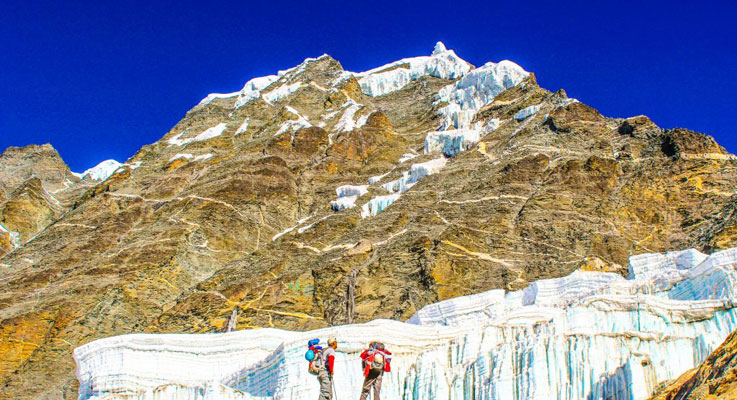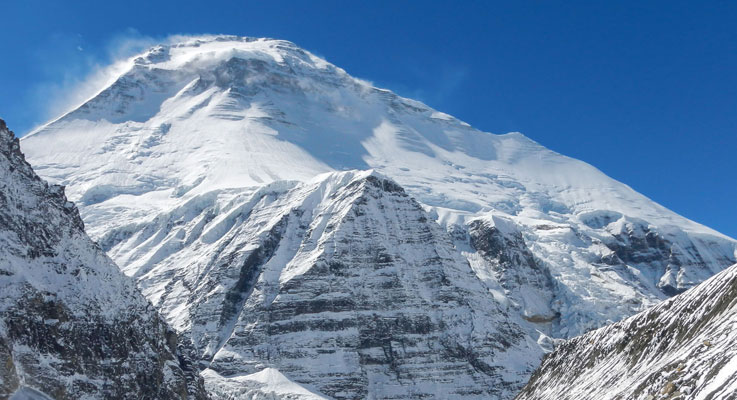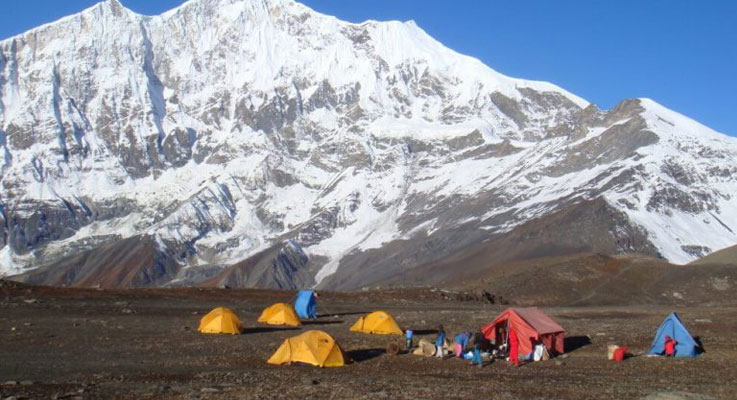-
Day 1
Arrival in Kathmandu
Today marks the beginning of this exotic adventure into the wild nature of the Everest region in Nepal. The capital of this beautiful mountainous country of Nepal, Kathmandu is the only city with an international airport. Upon arriving in Kathmandu from your respective locations today our representative will transfer you to the hotel.
You have the option to stroll around in the warm and welcoming streets of the throbbing capital. Another option is the relish the unique and the world famous Nepali cuisine. The adventure starts soon, and you should rest adequately and become strong for the adventure to follow.
-
Day 2
Drive from Katmandu to Pokhara
Drive to the beautiful city of Pokhara on a scenic drive. Follow the roaring Trishuli River and terraced farmlands to reach the relaxed town of Pokhara, situated beneath the Annapurna Range. Pokhara Valley is considered to be one of the most picturesque and revered spots in Nepal. It is rightly called as the lake city due to its abundance of beautiful lakes, the major attraction being the Phewa Lake. These lakes arise from the glaciers of the Annapurna Range. Lakeside is the district situated along the sides of the Phewa Lake. Phewa Lake reflects back the panorama of the beautiful Dhaulagiri, Macchapucchre, Annapurna peaks and other rising above us. Macchapucchre is only 28 kilometers from Phewa Lake and the views of this beautiful mountain are the most alluring from this point.
-
Day 3
Drive from Pokhara to Beni& trek to Babiachor
The trek starts today. We drive from Pokhara to Beni in a 3-hour drive, followed by a trek to Babaichor. The trail passes through the north bank of MyagdiKhola and transverses through BeniMangalghat, Singa, Tatopani (hot springs) and finally to Babiabhor. Approximately 3 hours of drive & approximately 3 hours of trek.
-
Day 4
Trek from Babiachor to Dharapani
Through the widened valley, the trail passes through villages of Shahashradhara and Ratorunga. The valley widens at this point and reaches terraced hills. The trail now becomes fairly level as you pass through the DukKhola. We pass again through grassy fields to reach Ratorunga. The valley narrows again and disappears on either side of the river. Finally, the day ends at Dharapani. Approximately 6 hours of trek.
-
Day 5
Trek from Dharapani to Muri
Cross the river to the West Bank and leave behind Phedi. The trail now becomes earnest and you need to climb at a fast pace with extremely difficult steps. After many switchbacks, we arrive at the ridge of the village of Sibang, Mattim, GattiKhola, PhalaiGaon and finally to the Magar village of Muri. Approximately 5 hours of trek.
-
Day 6
Trek from Muri to Boghara
Descend, cross a stream and trek through beautiful terraced fields to reach a pass. The ridge offers mind-boggling views of the south face of Mt. Ghustung. Later, we descend down to MyagdiKhola and reach the village of Naura from the West Bank. Later, we transverse through a grassy hill through several more switch-backs to reach Boghara. Approximately 6 hours of trek.
-
Day 7
Trek from Boghara to Dobang
This day starts with a descent through terraced fields finally reaching a small ridge. We move on to cross a forest to reach Jyardan. Jyardan is the most remote permanent settlement in this part. Through this village, we cross winding paths to reach the village of Lipshe. Lipshe is home to a single hut. We continue further through a forest to the LapcheKharkha. With the expectation of up-close views of the mountain cheering us on, we climb to a leveled area at Dobang. Approximately 5 hours of trek.
-
Day 8
Trek from Dobang to CharibanKhola
Cross a wooden bridge and descend to a forested area. The west face of Dhaulagiri becomes visible through the breaks in the trees. Descend downwards to the MyagdiKhola and cross a wooden village. We continue onwards to Chartare. The forests greet was again as we continue towards to pass through a rocky area. Finally, after crossing a stream, we reach ChoribanKhola. Approximately 5 hours of trek.
-
Day 9
Trek from ChoribanKhola to Italian Base Camp
Follow a trail to the moraine of the Chhonbarban Glacier. Enter the glacial moraine from the right as you are cheered on by the views of the Tukuche Peak. We walk on for a short time more and reach the Italian Base Camp. This is the site of camping for the night and is home to the magnificent panorama of peaks like the Dhaulagiri II, Dhaulagiri II and Dhaulagiri V. Approximately 7 hours of trek.
-
Day 10
In Italian Base Camp
As we have reached an altitude exceeding 3000 m, we will use this day to acclimatize with the increase in altitude. Acclimatize with the thinning air as views of Dhaulagiri II, Dhaulagiri V, and Dhaulagiri III appear before us and cast a whitish, beautiful, glow all around. We need to be fully tuned for the increasing altitudes, as we move on to explore more mind-boggling views of the Dhaulagiri range.
-
Day 11
Trek from Italian Base Camp to Glacier Camp
Walk through treacherous paths, prone to stone fall. We will need to be on the lookout for the strenuous path today. Through a narrow gorge, the trail takes us near a glacier before ending in the Glacier Camp. We need to move out in the better part of the morning, to reach the Glacier Camp by the evening when the weather is clear. Approximately 6 hours of trek.
-
Day 12
Trek from Glacier Camp to Dhaulagiri Base Camp
An adventure filled day as we reach the Dhaulagiri Base Camp today. We set off early today, as this day is an interesting one. Cross rocky paths in order to reach the Base Camp. Look up to the impressive mastiff od the Dhaulagiri I which dominates the skyline. Dhaulagiri II, Dhaulagiri II, and Dhaulagiri V also appear in the scene and an impressive icefall descending down from the northeast col makes up for a heavenly and picturesque experience. Approximately 7 hours of trek.
-
Day 13
Trek from Dhaulagiri Base Camp to Hidden Valley via French Pass
We start off the day by crossing a glacier. Cut through the mountain flank and cross the moraine as you climb terraced hills and walk across the moraine to reach the French Pass. The French Pass opens up a magnificent vista which offers views of the MukutHimal, Tashi Kang, SitaChuchura and the Tukuche Peak. Continue further to cross the Thapa Pass and descend down to the Hidden Valley with mind-boggling sights of the mountain peaks on the way. Approximately 6 hours of trek.
-
Day 14
Trek from Hidden Valley to Yak Kharka via Dhampus Pass
We descend down from the Hidden Valley in order to reach the Champions pass. As you drop down to the Dhampus Pass, which offers scenery of the white tops of mountains shining and smiling at us in their full glory. Descend downwards to Yak Kharka which has a perfect camping site which offers views of the surrounding panorama. Approximately 6 hours of trek.
-
Day 15
Trek from Yak Kharka to Jomsom
Continue downwards to the village of Marpha, known for its abundance of apples. We pass through the west bank of the Kali Gandaki River in order to reach this beautiful village. Taste the local Apple Brandy as you continue north the river valley to the dry, arid and mystical Jomsom. Jomsom is a beautiful town situated in between the two giants of Dhaulagiri and Annapurna and has its mystical beauty of its own.
Jomsom spreads over both banks of the Kali Gandaki River and is a perfect spot to witness the views of the towering backdrop of the Dhaulagiri and Nilgiri peaks. You can find merchants and local inhabitants going about their daily work there. The awesome splendor of the mountain peaks glistening all around, combined with the mystique of the people living in Jomsom, makes this town a perfect mixture of beauty and splendor. Jomsom is the gateway to Mustang and is also home to a small airport.Approximately 5 hours of trek.
-
Day 16
Fly from Jomsom to Pokhara& drive to Kathmandu
It is finally time to bid farewell to the beautiful Annapurna region as we fly back to Pokhara from Jomsom. Bid goodbye to the exceptionally beautiful Annapurna region and reach Pokhara. From Pokhara, we head back to Kathmandu on a 6 hours’ drive. Approximately 20 minutes of flight. Approximately 6-7 hour drive.
-
Day 17
Optional sightseeing in Kathmandu
This day is separated for optional sightseeing in Kathmandu. There are many places in the capital of Nepal, like the Boudhanath, Syambunath as well as Pashupati, which are worth visiting. Boudhanath is the largest stupa in the world while Syambunath is commonly called as the Monkey Temple for the huge number of monkeys found there. Pashupatinath is the holy temple of Hindu people and a sacred spot which cannot the accessed by foreigners. The rest of the evening can be spent by doing some souvenir shopping for loved ones back home. Thamel is the perfect location to shop for supplies and souvenirs. You will spend the night in the hotel.
-
Day 18
Depart transfer
After the experience of a lifetime, you will finally bid farewell to the Himalayan country of Nepal. Keeping the memories of this adventure in mind and with a promise to come back for more, you can finally depart from the country. You will be transferred to the airport for your safe flight back home.




